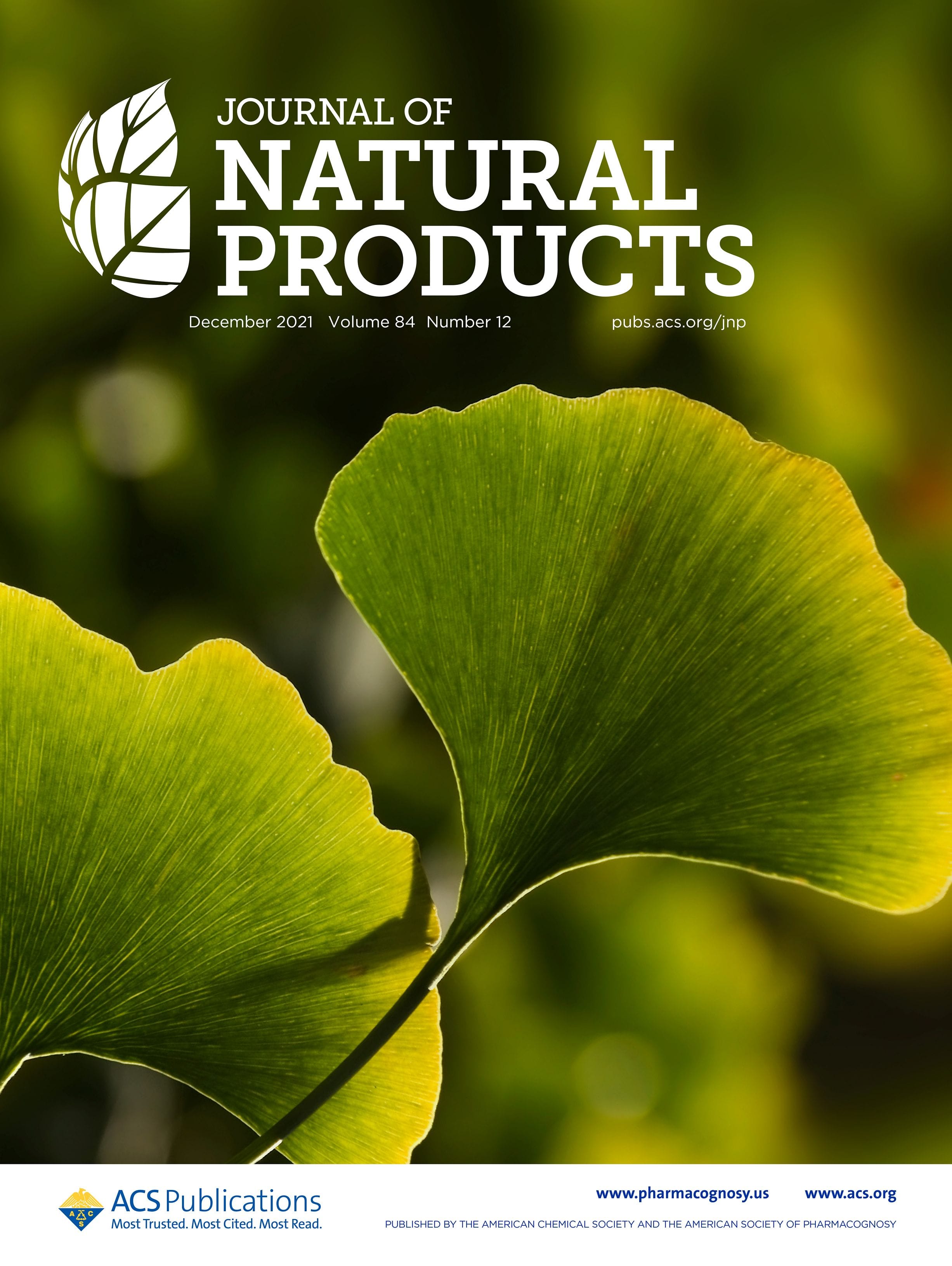The Journal of Natural Products, in partnership with the American Society of Pharmacognosy (ASP), is thrilled to announce the 2020 winners of the Arthur E. Schwarting and Jack L. Beal Awards. This initiative was launched in 2001 by the Foundation Board of ASP to recognize some of the best work published in the Journal of Natural […]

The Journal of Natural Products, in partnership with the American Society of Pharmacognosy (ASP), is thrilled to announce the 2020 winners of the Arthur E. Schwarting and Jack L. Beal Awards.
This initiative was launched in 2001 by the Foundation Board of ASP to recognize some of the best work published in the Journal of Natural Products on an annual basis, in fond remembrance of two distinguished former editors of the journal.
- The Arthur E. Schwarting Award is open to all papers published in the journal within a given year.
- The Jack L. Beal Award is given to early-career investigators (within 12 years of receiving their Ph.D. or within 10 years of gaining their first professional appointment, such as Assistant Professor or an equivalent position in industry or government).
- A two-tiered process is used each year to determine the winners: Journal of Natural Products Editors nominate eight papers for the awards, and the ASP President appoints an ad hoc committee to make the final selections.
2020 Jack L. Beal Award-Winning Paper
Synthesis and Biological Evaluation of Tryptamines Found in Hallucinogenic Mushrooms: Norbaeocystin, Baeocystin, Norpsilocin, and Aeruginascin
Alexander M. Sherwood*, Adam L. Halberstadt, Adam K. Klein, John D. McCorvy, Kristi W. Kaylo, Robert B. Kargbo, and Poncho Meisenheimer
J. Nat. Prod. 2020, 83, 2, 461–467
DOI: 10.1021/acs.jnatprod.9b01061
Interview with Awardee Alexander Sherwood of Usona Institute:

What is the significance of the 2020 Beal Award-winning paper?
The report aimed to provide the first step toward understanding if other tryptamine natural products present in psychedelic mushrooms, apart from psilocybin and psilocin, could also possess psychoactive properties. To enable pharmacological study, we developed synthetic methods that solved a few challenges associated with isolating purified solid zwitterionic phosphorylated tryptamines. The pharmacological data indicated that while active at the serotonin-2A receptor, the tested compounds may not efficiently reach the brain to elicit a psychoactive effect. This was one of the first published works from Usona’s psychedelic research laboratory, and we are honored to see that it has brought attention and inquiry to these fascinating natural products.
2020 Arthur E. Schwarting Award-Winning Paper
Bioreductively Activatable Prodrug Conjugates of Combretastatin A-1 and Combretastatin A-4 as Anticancer Agents Targeted toward Tumor-Associated Hypoxia
Blake A. Winn, Laxman Devkota, Bunnarack Kuch, Matthew T. MacDonough, Tracy E. Strecker, Yifan Wang, Zhe Shi, Jeni L. Gerberich, Deboprosad Mondal, Alejandro J. Ramirez, Ernest Hamel, David J. Chaplin, Peter Davis, Ralph P. Mason, Mary Lynn Trawick*, and Kevin G. Pinney*
J. Nat. Prod. 2020, 83, 4, 937–954
DOI: 10.1021/acs.jnatprod.9b00773
Interview with joint Awardees Kevin Pinney and Mary Lynn Trawick of Baylor University
What does the 2020 Schwarting Award mean to you?
We are extremely honored to have been selected as recipients of the 2020 Arthur E. Schwarting Award for our co-authored 2020 publication in the Journal of Natural Products. It is especially noteworthy that this award honors and celebrates the outstanding legacy of Professor Arthur E. Schwarting, who made life-long seminal contributions to the field of natural products research and thus significantly advanced this area of research inquiry.
While the award is presented by the American Society of Pharmacognosy (ASP), it is shared by the American Chemical Society (ACS) through a unique partnership between the ASP and the ACS that supports the publication of the Journal of Natural Products. Thus the award also celebrates this highly productive collaboration between these two outstanding professional societies (APS and ACS). For us, the award represents a celebration of the shared efforts reflected through the invaluable contributions of the co-authors of this publication. Each of these individuals made uniquely important contributions that collectively reflect a wide range of scientific inquiry, including synthetic organic chemistry, biochemistry, cell biology, imaging, and drug discovery and development.
What draws you to research involving natural products?
Natural products present a rich pharmacopeia of structurally diverse molecules that often demonstrate promising profiles of biological activity. Nature provides incredible chemical and biological diversity of compounds that can be used as leads for drug development. As such, natural products, along with structurally modified analogs and derivatives, continue to serve as lead therapeutic candidates in a myriad of drug discovery and development campaigns.
It is a special privilege of ours that the natural products showcased in this manuscript, combretastatin A-4 (CA4) and combretastatin A-1 (CA1), were discovered and pioneered by Professor George R. Pettit (Arizona State University), who is world-renowned as a highly prolific and influential scholar. Professor Pettit has dedicated much of his life’s work toward the eradication of cancer. His research has resulted in the discovery and advancement of many promising natural products (along with associated analogs) as potential therapeutic agents for the treatment of cancer, and his work has inspired future generations of scientists to pursue careers that include natural products and cancer treatment as highlighted themes. It is a further honor to know Professor Robert (Bob) Pettit both as a collaborator and a friend, and we have celebrated this relationship through a tribute to Bob Pettit in this manuscript.
How did the collaboration between the Pinney and Trawick Research Groups come about?
The collaboration between our two research groups (the Pinney Group: organic and medicinal chemistry and the Trawick Group: biochemistry and cell biology) started with research on tubulin-binding molecules as anticancer agents. This program focused on small-molecule inhibitors of tubulin polymerization with an emphasis on vascular disrupting agents (colchicine-site, tubulin-binding molecules that resulted in tumor vasculature shutdown) and involved aspects of fundamental discovery science as well as efforts towards translational development of therapeutic agents for the treatment of cancer. A number of molecules that emerged from our collaborative program demonstrated potent cytotoxicity against human cancer cell lines and also preliminary in vivo efficacy. Ongoing studies have focused on strategies to take advantage of the potency of these compounds while improving their selectivity for the tumor microenvironment, and in this regard, we initiated a program in collaboration with Dr. David (Dai) Chaplin (then at OXiGENE Inc.) over a decade ago on prodrugs that could be bioreductively activated in hypoxic tumors. Inspiration for these studies was fueled by the previous advancement of tirapazamine to clinical trials, along with the early pioneering work by Dr. Peter Davis related to hypoxia-activated combretastatin prodrugs, and the encouragement by Dr. Chaplin in regard to potential therapeutic translation.
What are the attributes of your 2020 Journal of Natural Products publication?
The chaotic tumor vasculature, characterized by impaired microcirculation and increased diffusional distances combined with rapid tumor growth, results in a lack of oxygen or hypoxia in many tumor cells. Hypoxia in tumors and cancer cells leads to genetic instability with increased conversion of the epithelial to a mesenchymal phenotype, promoting tumor cell proliferation, migration, and metastasis. Hypoxic tumors undergo a signaling and metabolic transformation, becoming more resistant to both chemotherapy and radiotherapy. In general, tumor hypoxia is associated with poor clinical outcomes. Therefore targeting hypoxic cells in tumors with potent anticancer agents offers an opportunity for enhanced selectivity with antimetastatic potential. The bioreductively activatable prodrug conjugates (BAPCs) advanced in this publication are based on the natural products CA4 and CA1, which are structurally similar with the distinction that CA1 bears an orthodihydroxy functionality in the aromatic B-ring whereas CA4 features a single phenolic moiety.
What are the next steps for this research?
Preliminary in vivo pharmacodynamic and pharmacokinetic studies conducted in collaboration with Dr. Ralph P. Mason (University of Texas Southwestern Medical Center) are quite promising, but more detailed studies are required. These studies would greatly benefit from improved aqueous solubility of our bioreductive prodrugs. Enhanced targeting through cleavable protein conjugates that bind to specific cell surface tumor markers represents another priority in this work. In addition, numerous other small-molecule analogs have been designed, synthesized, and evaluated for their cytotoxicity (in our laboratories) and for their ability to function as inhibitors of tubulin polymerization through a long-standing collaboration with Dr. Ernest Hamel (National Cancer Institute), who also serves as a co-author of this publication. The most promising of these molecules will be prepared as their corresponding BAPCs for further biological evaluation.
